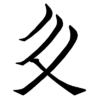Tangut script
| Tangut | |
|---|---|
 The Art of War written in Tangut script | |
| Type |
Logographic
|
| Languages | Tangut language |
| Creator | Yeli Renrong |
Time period | 1036–1502 |
Parent systems | |
| Direction | Left-to-right |
| ISO 15924 |
Tang, 520 |
Unicode alias | Tangut |
| |
The Tangut script (Chinese: 西夏文 xī xià wén) was a logographic writing system, used for writing the extinct Tangut language of the Western Xia Dynasty. According to the latest count, 5863 Tangut characters are known, excluding variants.[1] The Tangut characters are similar in appearance to Chinese characters,[2] with the same type of strokes, but the methods of forming characters in the Tangut writing system are significantly different from those of forming Chinese characters. As in Chinese calligraphy, regular, running, cursive and seal scripts were used in Tangut writing.
According to the History of Song (1346), the script was designed by the high-ranking official Yeli Renrong under Western Xia Emperor Li Yuanhao's supervision in 1036.[3][4] The script was invented in a short period of time, and was put into use quickly. Government schools were founded to teach the script. Official documents were written in the script (with diplomatic ones written bilingually). A great number of Buddhist scriptures were translated from Tibetan and Chinese, and block printed in the script.[5] Although the dynasty collapsed in 1227, the script continued to be used for another few centuries. The last example of the script occurs on a pair of Tangut dharani pillars found at Baoding (130 km southwest of Beijing), which were erected in 1502.[6]
6,125 characters of the Tangut script were included in Unicode version 9.0 in June 2016 in the Tangut block. 755 Radicals and components used in the modern study of Tangut were added to the Tangut Components block, and the Tangut iteration mark was included in the Ideographic Symbols and Punctuation block.[7]
Structure


The [Tangut] language is remarkable for being written in one of the most inconvenient of all scripts, a collection of nearly 5,800 characters of the same kind as Chinese characters but rather more complicated; very few are made up of as few as four strokes and most are made up of a good many more, in some cases nearly twenty. It is extremely difficult to remember them, since there are few recognizable indications of sound and meaning in the constituent parts of a character, and in some cases characters which differ from one another only in minor details of shape or by one or two strokes have completely different sounds and meanings.[8]
Tangut characters can be divided into two classes: simple and composite. The latter are more numerous. The simple characters can be either semantic or phonetic. None of the Tangut characters are pictographic, while some of the Chinese characters were at the time of their creation; this is one of the major differences between Tangut and Chinese characters.

Most composite characters comprise two components. A few comprise three or four. A component can be a simple character, or part of a composite character. The composite characters include semantic-semantic ones and semantic-phonetic ones. A few special composite characters were made for transliterating Chinese and Sanskrit.

There are a number of pairs of special composite characters worth noting. The members of such a pair have the same components, only the location of the components in them is different (e.g. AB vs. BA, ABC vs. ACB). The members of such a pair have very similar meanings.
See also
References
- Grinstead, Eric (1972). Analysis of the Tangut Script. Scandinavian Institute of Asian Studies Monograph Series No. 10. Lund: Studentlitteratur.
- Kychanov, E.I. (1996). "Tangut", in Peter T. Daniels & William Bright (ed.), The World's Writing Systems, New York: Oxford University Press, ISBN 0-19-507993-0, pp. 228–9.
- (Japanese) Nishida Tatsuo 西田龍雄 (1994). Seika moji: sono kaidoku no purosesu (西夏文字 : その解讀のプロセス "Xixia script: the process of its decipherment"). Tokyo: Kinokuniya shoten. ISBN 4-314-00632-3.
- (Chinese) Shi Jinbo 史金波 (1981). "Lüelun Xixia wenzi de gouzao" (略论西夏文字的构造 "A sketch of the structure of the Tangut script"), in Minzu yuwen lunji (民族语文论集 "A collection of essays concerning the languages of the ethnic minorities"), Beijing: Zhongguo shehui kexue chubanshe, pp. 192–226.
Notes
- ↑ (Chinese) 《西夏文字共有5863个正字》,宁夏新闻网
- ↑ Frederick W. Mote (2003). Imperial China 900-1800. Harvard University Press. pp. 395–. ISBN 978-0-674-01212-7.
- ↑ (Chinese) 《宋史‧卷四百八十五‧列传第二百四十四‧外国一‧夏国上》
- ↑ Heming Yong; Jing Peng (14 August 2008). Chinese Lexicography : A History from 1046 BC to AD 1911: A History from 1046 BC to AD 1911. OUP Oxford. pp. 377–. ISBN 978-0-19-156167-2.
- ↑ (Chinese) 徐庄,《略谈西夏雕版印刷在中国出版史中的地位》,出版学术网
- ↑ Nishida, Tatsuo (2010). translated by Noriyoshi Mizujulle, Anthony George and Hamaki Kotsuki. "Xixia Language Studies and the Lotus Sutra (II)" (PDF). The Journal of Oriental Studies. 20: 222–251.
- ↑ Unicode version 9.0.0
- ↑ Clauson, Gerard (1964). "The Future of Tangut (Hsi Hsia) Studies" (PDF). Asia Major. (New Series). 11 (1): 54–77.
External links
| Wikimedia Commons has media related to Tangut script. |
- Tangut script at Omniglot
- Tangut script, by Andrew West
- (Japanese) Sample Tangut characters at Mojikyo
- (Japanese) 大西 磨希子・北本 朝展,『文字が語りかける民族意識:カラホトと西夏文字』,ディジタル・シルクロード
- 史金波. 《西夏文字是有规律的文字吗?》 (in Chinese). 宁夏新闻网. Retrieved 2014-09-09.